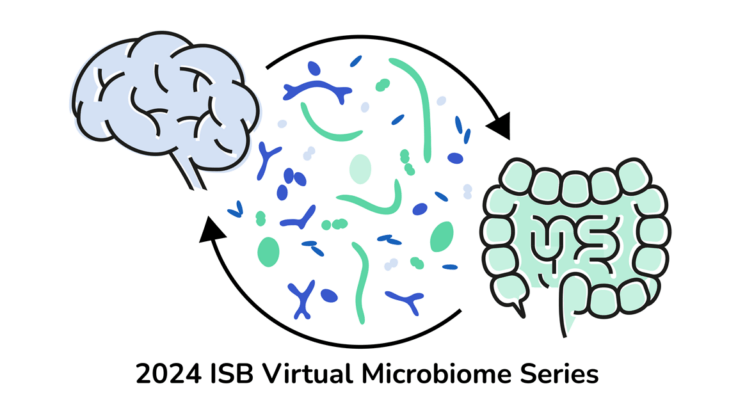A New Path Toward Microbiome-Informed Precision Nutrition
 gibbons.isbscience.org/news/2024/06/24/a-new-path-toward-microbiome-informed-precision-nutrition/
gibbons.isbscience.org/news/2024/06/24/a-new-path-toward-microbiome-informed-precision-nutrition/Short-chain fatty acids (SCFAs) are beneficial molecules created by the bacteria residing in our gut that are closely tied to improved host metabolism, lower systemic inflammation, better cardiovascular health, lower cancer risk, and more. However, SCFA profiles can vary widely between individuals consuming the same exact diet and we currently lack tools for predicting this inter-individual variation.
ISB researchers have developed a novel way to simulate personalized, microbiome-mediated responses to diet. They use a microbial community-scale metabolic modeling (MCMM) approach to predict individual-specific SCFA production rates in response to different dietary, prebiotic, and probiotic inputs.

Cover Art by Sam D’Orazio/ISB
In other words, ISB scientists can build a “digital twin” of gut microbiome metabolism that can simulate personalized responses to diet, using gut microbiome sequencing data and information on dietary intake to constrain each individual-specific model. They detailed their results in a paper published in Nature Microbiology.
“To a first approximation, the gut microbiome is a bioreactor that converts dietary fibers into these SCFAs,” said Dr. Sean Gibbons, ISB associate professor and co-senior author. “Understanding how the ecology of the gut and dietary intake can be quantitatively mapped to SCFA outputs will represent a major advance in translating microbiome science into the clinic.”
Unlike black-box machine learning approaches to prediction, MCMMs are transparent and mechanistic, with tens of thousands of metabolites and enzymes across dozens of organisms providing a high degree of knowledge about the specific microbes, dietary components, and metabolic pathways that contribute to SCFA production. Despite this transparency, the complexity of these models makes them difficult to experimentally validate.
One approach is to measure SCFA production rates for an entire ecosystem, and then compare these ecosystem-scale measures to their cognate model predictions. However, measuring SCFAs in the wild is tricky because the body rapidly consumes them after they are created. In order to overcome this challenge, the authors measured SCFA production rates from in vitro (i.e., test tube) communities of random mixtures of human gut bacterial isolates and from ex vivo (i.e., outside the body) stool homogenates from different humans incubated in an anaerobic chamber with a variety of dietary fibers.
By isolating microbiota-driven SCFA production from host absorption, ISB scientists were able to show that MCMM predictions were significantly correlated with measured production rates across a range of fibers for both butyrate and propionate, two of the most abundant and physiologically potent SCFAs.
While in vivo (i.e., in the body) measurements of butyrate and propionate production were not feasible, the authors were able to use indirect associations between SCFA production rates and blood-based health markers to validate the physiological effects of inter-individual differences of production. First, they showed that MCMM predictions could differentiate between individuals from a high-fiber feeding study who showed divergent immune responses: most individuals showed a reduction in systemic markers of inflammation, but a subset of people showed an increase in inflammation on a high-fiber diet. Individuals in the high-inflammation response group showed a significantly reduced capacity for producing propionate, according to MCMM predictions. Next, the authors showed that butyrate predictions were significantly associated with blood markers of cardiometabolic and immune health in a population of over 2,000 individuals. Specifically, higher MCMM-predicted butyrate production was significantly associated with lower LDL cholesterol, lower triglycerides, improved insulin sensitivity, lower systemic inflammation, and lower blood pressure.
“The predictive accuracy of MCMMs in vitro, coupled with the significant associations between SCFA predictions and health markers in human cohorts, gives us confidence in the utility of these models for precision nutrition,” said lead author Dr. Nick Quinn-Bohmann, a University of Washington graduate student at ISB who recently defended his dissertation.
After validating MCMM predictions in a variety of ways, the authors then demonstrated the potential of this approach for designing personalized prebiotic, probiotic, and dietary interventions that optimize SCFA production profiles. They simulated butyrate production rates for two different diets – the standard Austrian diet (i.e., standard European diet) and a vegan high-fiber diet – across a cohort of over 2,000 individuals from the Pacific West of the US. They found that a small subset of individuals showed almost no increase in butyrate production when switched to the high-fiber diet (termed “non-responders”) and another subset actually saw a small drop in butyrate production on the high-fiber diet (termed “regressors”). Next, they simulated three simple co-interventions on both background diets to try and augment butyrate production in the non-responders and the regressors: adding the prebiotic fiber inulin, adding the prebiotic fiber pectin, or adding a butyrate-producing probiotic (Faecalibacterium). The results showed that no single combinatorial intervention was optimal across all individuals: some benefited most from adding a prebiotic fiber, while others appeared to require the addition of a butyrate-producing probiotic to their microbiota.
“Together, these results represent an important proof of concept for a novel path forward in microbiome-mediated precision nutrition,” said Dr. Christian Diener, co-senior author and assistant professor at the Medical University of Graz in Austria. “But, of course, there is more work to do to validate the predictive capacity of these models in prospective human trials before they can enter clinical practice.”
Video transcript
Below is the video transcript of the conversation between Drs. Sean Gibbons and Nick Quinn-Bohmann:
Sean Gibbons:
Hello, I’m Sean Gibbons, an Associate Professor at the Institute for Systems Biology, and our lab studies the human microbiome and how it affects human health and disease.
Today, I’m here to talk about our latest paper, which is about to come out online in the Journal of Nature Microbiology. This work was driven by Dr. Nick Quinn-Bohmann, a PhD student in the lab, who recently graduated and got his PhD, and also with my co-senior author Christian Diener, who’s now Assistant Professor at the Medical University of Graz in Austria.






